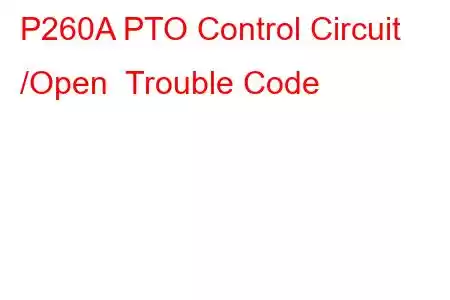P260A PTO Control Circuit /Open
OBD-II Trouble Code Technical Description
PTO Control Circuit /Open
What does that mean?
This is a generic powertrain diagnostic trouble code (DTC) and applies to many OBD-II vehicles (1996-newer). That may include but is not limited to vehicles from Ford, GMC, Chevy, Dodge, Ram, etc. Although generic, the exact repair steps may vary depending on year, make, model and powertrain configuration.
OBD-II trouble code P260A and related codes P260B, P260C and P260D are associated with the PTO or power take off control circuit.
The PTO or power take-off is a system that is linked to the transmission of the vehicle and is used to drive auxiliary equipment. That auxiliary equipment might include things such as a winch, snow plow, dump bed, etc.
When the PCM detects improper voltage or resistance within the PTO control circuit, code P260A will be set and the check engine light, service engine soon light or both may be illuminated.
What is the severity of this DTC?
The severity of this code is generally not severe because it will likely only affect PTO functions but not regular vehicle functions.
What are some of the symptoms of the code?
Symptoms of a P260A trouble code may include:
Auxiliary PTO equipment will not function Check engine light illuminatedWhat are some of the common causes of the code?
Causes for this P260A code may include:
Defective PTO relay coil control Open or short in PTO control circuit Faulty or damaged wiring Corroded, damaged or loose connector Defective fuse or fuse-able link (if applicable) Defective PCMWhat are some P260A troubleshooting steps?
The first step in the troubleshooting process for any malfunction is to research the Technical Service Bulletins (TSB's) for the specific vehicle by year, model and engine/transmission configuration. In some circumstances, this can save a lot of time in the long run by pointing you in the right direction.
The second step is to locate all components associated with the PTO power take-off circuit and look for obvious physical damage. Perform a thorough visual inspection to check the associated wiring for obvious defects such as scraping, rubbing, bare wires, or burn spots. Next is to check the connectors and connections for security, corrosion and damaged pins. This process must include all wiring connectors and connections to all components including the PCM. Consult the specific tech data for the vehicle to verify the configuration of the oil level safety circuit and see if a fuse or fuse-able link is incorporated into the circuit.
Advanced Steps
The advanced steps become very vehicle specific and require the appropriate advanced equipment to perform accurately. These procedures require a digital multimeter and the specific technical references for the vehicle. In this situation, an oil pressure gauge may facilitate the troubleshooting process.
This article is strictly informational and the specific technical data and service bulletins for your vehicle should always take priority.
Read: 19


